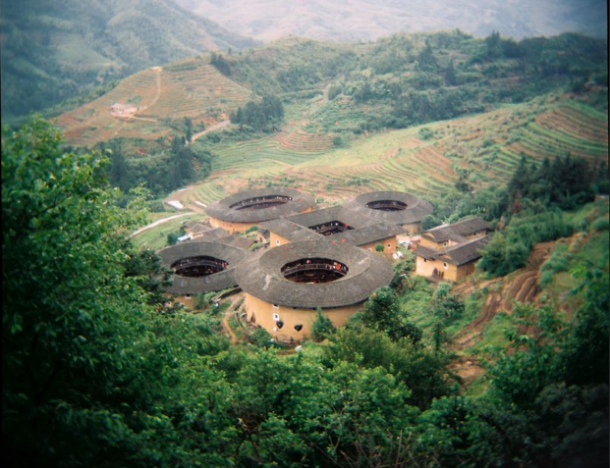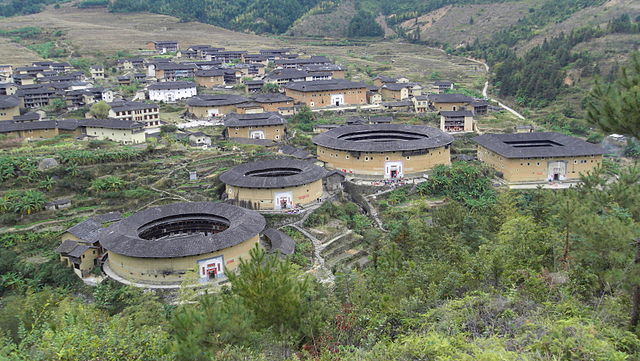
News
In China, Double-Edged Sword Of World Heritage Status
Source:http://www.worldcrunch.com/
Date:2014-03-20
The Fujian Tulous, mysterious circular Chinese buildings, were named a World Heritage site in 2008. It has raised both investments and fears.

A uniquely functional beauty
YONGDING — The large and enclosed Tulous, the unique fortified circular earthen buildings clustering mainly in the mountainous areas of China's southeastern Fujian province, are indeed a vision to behold.For too long, however, their cultural relevance was ignored. But that all began to change when they were inscribed by the UNESCO as a World Heritage site in 2008. The United Nations organization celebrated them as "exceptional examples of a building tradition and function," and have since attracted massive interest from researchers and tourists, both inside and outside of China.
"They are totally packed during these long holidays. Visitors just wait in line one after another to move further," said Lin Rigeng, a Yongding local celebrity better known as the "Tulou Prince". He owns the Zhenchenglou, one of the province’s finest Tulous that has been visited by many foreign dignitaries.
In 2013 alone, 4.3 million Chinese and foreign tourists visited Yongding County, a 7.2% increase from 2012. This brought in a tourism income of 3.18 billion RMB — about $511 million — which marked a 11.6% rise compared with the previous year. The local authorities may soon switch their economic model from coal mining to the tourism industry.
Everything changes
As it often happens, larger issues have come up. How will authorities balance the development of Yongding as a tourist destination with support for other local sources of livelihoods? Can commercial development and cultural preservation coexist?
Since listed as a World Heritage Site, seven of Hongkeng village's Tulous have been named "protected buildings" by the local government, and a folk-cultural area was developed around the site. The Yongding authorities have spent millions in what they call a tourist "Tulou golden corridor."

Mixing in with more modern structures — Photo: Wikimedia
It all started when a state-owned holding company, the Hakka Tulou Tourism Development Company, was set up. The company's idea was to develop this once poverty-ridden village, using a mixed management model that would combine both tourist attractions and urban communities — while allowing visitors to enjoy a "contemporary rural life."
The villagers were, at first, truly happy about the idea and the benefits tourism could bring. Yet the enchantment was soon over, and concerns started to grow. Building new houses was the first, most important issue. All the existing buildings that did not match the Tulous' architectural style were to be destroyed, while it was forbidden to build new houses in the village.The local government promised to relocate villagers in replacement housing, but this pledge has yet to be honored. As young people got married and the housing demand rose, this became a larger issue.
"Many villagers working in cities hesitate to come home now, even during the Spring Festival holiday," said Lin Zhensheng, a local resident. "They have nowhere to stay, unless they pay to sleep in hotels or at other villagers' places."
Local officials say it is hard for them to acquire villagers' land for collective relocation. Meanwhile, villagers are voicing a growing distrust of the government, pointing out the fact that, while Tulous are leased as scenic spots, much of the land surrounding them was expropriated to build roads, hotels and other facilities for tourists.
Show me the money
Another tension between authorities and the villagers relates to the uneven distribution of the income brought in by local tourism. As one villager said, what local residents earn — a "dividend" that depends on ticket sales — is only a rather modest "nuisance fee", while, according to the legislation, villagers are entitled to receive a more lucrative "resource fee."
As hosts of the Tulous' scenic resources — and tourist resources themselves — villagers believe they can play an essential role in tourism development. Yet, they say, they don't get a fair share of the ticket sale revenue. Meanwhile, the Hakka Tulou Tourism Development Company, which represents the government's interests, claims that without its investment and advertising around the sites, the village would never attract so many visitors.
"Before the Tulous became a World Heritage site, villagers were full owners of these ancestral properties. But today, these sites have become the country's, and even the world's, common property," said the Yongding Office of Tourism Industry Development Committee. "Though residents still have property rights, they are no longer the masters of these touristic resources." >
Several conflicts have thus occurred between villagers and the tourism company. Many clashes, for instance, took place when villagers' relatives and friends came to the site as guests, and were stopped by security guards at its entrance.
Developing or preserving?
As the local government tries to make the Tulous sites a "strategic pillar industry," many commercial tourism projects were launched and are now in full swing. One of them is a "Dream Tulou," an old town built to become a movie base.
Some villagers claim the government is focusing all of its energy on tourism development, instead of protecting the province's architectural treasures. These sites have certainly suffered from the roads, public restrooms, hotels and other facilities that were built to accomodate tourists.
Plus, if we look at the Hongkeng village, only seven of its Tulous were named "cultural relics" and are thus maintained by the government. What happens to the other ones? As villagers have left these old dwellings, there is a clear lack of motivation to repair these houses. This greatly impacts the global image of these ancient villages.
A Tulous tourism company executive, also a native of the area, admitted that the site management system has some flaws. This, on the long run, could lead to an impeded protection and development of the site.
It is indeed the state-owned tourism company, a non-administrative body, that takes care of the investments and commercial development of the Tulous, while the Yongding Office of Tourism Industry Development Committee, and the Yongding Tourism Office, are the two agencies that coordinate and manage local tourism.
How do we coordinate these competing agencies' functions and realize the Tulous' full touristic potential? How do we preserve the sites themselves, while maintaining the villagers' livelihood? It's a lesson that becoming a World Heritage Site is only the beginning.
Copyright ©



